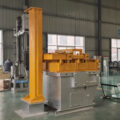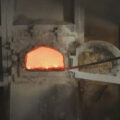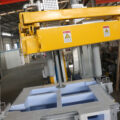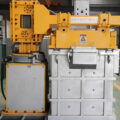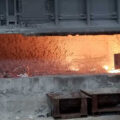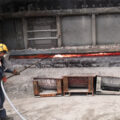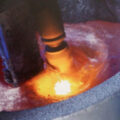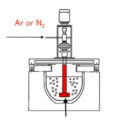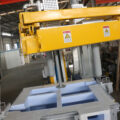Hydrogen is a harmful gas in molten aluminum. The pre-furnace detection of hydrogen content in molten aluminum is to ensure the quality of castings. Especially in the precision die casting process, the use of liquid aluminum degassing equipment to remove hydrogen and slag will become essential.
During the smelting process, aluminum metal reacts with water vapor to generate hydrogen, which is dissolved in the aluminum liquid. When the molten aluminum solidifies, hydrogen is removed from the molten aluminum. If the hydrogen content in the molten aluminum is too high, holes are easily formed in the casting, and the mechanical properties of the casting will decrease. In severe cases, the casting will be scrapped.

Principle of Liquid Aluminum Degassing
The molten aluminum is stirred by the controlled rotating graphite and rotor, while the metered inert gas is pressed into the molten aluminum and dispersed into small bubbles, which are evenly dispersed in the solution metal, and the air pressure of the bubbles is zero.
Due to the high partial pressure of hydrogen in the molten aluminum, the hydrogen in the molten aluminum continuously diffuses into the bubbles, and at the same time, some non-metallic inclusions in the molten aluminum are adsorbed on the surface of the bubbles.
The principle of rotating degassing is to increase the surface area of the inert gas exposed to the metal. The larger the surface area, the faster the degassing. For a given gas volume, the smaller the bubble size, the larger the surface area and the faster the degassing rate. For example, a 1″ square bubble has a surface area of 6 square inches.
If you divide this bubble into 1/16″ square bubbles, the total surface area will increase to 96 square inches. Therefore, for the same volume of gas, the surface area increases by 16 times the hydrogen transferred to the bubble. The bubbles will not interfere with melting The surface of the metal, so little hydrogen is absorbed from the atmosphere.
In the liquid aluminum degassing device, these impurities are separated before combustion, and then degassed by removing slag. Also recognized the principle of degassing, high efficiency, and does not affect the production process. In a short time, it can improve the purity of molten aluminum, reduce the scrap rate, increase production efficiency, improve the mechanical properties of castings, and increase the competitiveness of products.

